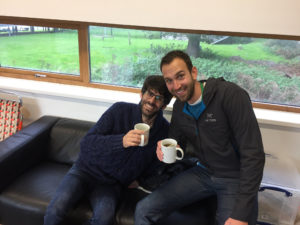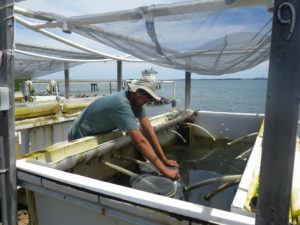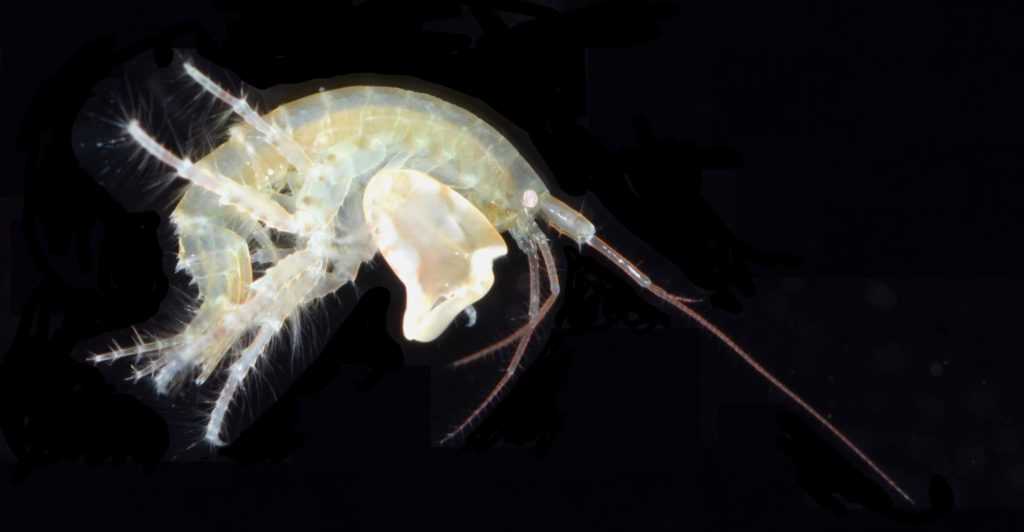by Kristen Minogue

Jon Lefcheck has spent most of his life on the East Coast. But as the new coordinating scientist for the Marine Global Earth Observatories (MarineGEO), he’s about to get a crash course in doing marine biology on the other side of the country and the other side of the globe. In this Q&A, learn about some of the weird discoveries and creatures he’s encountered so far, and why the coasts make society tick. Edited for brevity and clarity.
You were the first person in your family to go to college. What motivated you to push yourself in that way?
I always liked school—oddly enough, yeah, I know. I liked science. I pushed my parents to send me to private high school so that I could get more into my studies, and they were hugely supportive the entire way. I think that was their dream, that they would have a kid that would grow up to go on to college. My father said he wanted me to be a doctor when I was born. He meant medical doctor, so I’m not sure how he feels. But, you know, Ph.D.
How did you realize you wanted to be a marine biologist?
As a kid my parents would take us to Newport, Rhode Island. My mother’s aunt lives there. We’d go and I’d pick over the beach, and I always thought it was super exciting, but I never really realized you could make a career out of it until I got to college….I ended up doing a little project on snails that shoot around the rocky intertidal up in Maine. And in doing that and in reading papers and talking with [my advisor], suddenly I realized, oh my gosh, this could be a career. People do this for a living. It’s not just on National Geographic or Discovery Channel.
In 2017, right before you came to SERC, you helped document a record-breaking four-fold recovery of underwater plants in Chesapeake Bay. How did that come about?

That was probably my proudest accomplishment as a scientist. That was with a guy named Bob Orth down at VIMS [Virginia Institute of Marine Science]. He started a monitoring program of underwater vegetation, so not just seagrass but all kinds of grasses, including freshwater, in 1984, which was before I was even born….We had roughly 31 years of data to deal with at the time. So we thought, now is our chance to look back and see over a very long period of time how we’ve done in Chesapeake Bay in terms of promoting the recovery of these underwater grasses. It turns out, despite a large decline in the ’70s, from about the ’90s onward we’ve seen a huge resurgence. And that’s in large part due to our own efforts to police ourselves and the kinds of stuff that we’re dumping into the Bay, different kinds of pollutants, runoff from people fertilizing their lawns and fertilizing their crops. Those management efforts have actually paid off.
You joined SERC as part of the Marine Global Earth Observatories team, or MarineGEO. Could you explain what MarineGEO is?
MarineGEO is really unique in the sense that it’s a partnership, a community of collaborators that are distributed all over the world. We’ve got places in Florida, Panama, Belize, Hong Kong, Hawai’i, Vancouver, and they’re all committed to working together to go after questions about the health and future of coastal ecosystems. Seagrasses, coral reefs, mangroves, marshes, oysters, the whole gamut.
MarineGEO places a huge focus on biodiversity. Why should people care about coastal ecosystems, or how many species they have?
Coastal systems are providing a refuge for babies that grow up to create the foundation of coastal fisheries. So they’re important. You can start to put a dollar value on what they mean. They allow my colleagues and friends here or in Kansas, or my mother at home in Connecticut, to order striped bass at a restaurant and know that that came from, grew up in, probably seagrass bed in Chesapeake Bay. So being able to make a link between the health of those systems, show biodiversity plays into that….
That’s really what I would stress to somebody who comes up on the street. Why do I care about biodiversity? Biodiversity drives ecosystems. Ecosystems give us pretty much everything that we like along the coastline.
What’s your official role with MarineGEO?
I think we’ve settled on “coordinating scientist,” because I want it to be clear that I’m still doing science. That’s the primary goal of my position, to not just coordinate research among the MarineGEO partners, but also to actually conduct science, test hypotheses, publish papers, get to the bottom of some of these really interesting questions that could be answered with large networks like MarineGEO.
What are you most excited about on your new job?
I’m very excited to get out of Chesapeake Bay and visit some of these places. I’m not going to lie, that was very attractive about the position, to be able to go to Panama and Belize, places I’ve only ever seen in pictures….
I think really what I’m most excited about is harnessing the power of this network to really get at some generalizations about biodiversity. How is it distributed? What’s its role in the ecosystem? We have lots and lots of case studies, particular places, but very rarely do we have the opportunity to test these questions in the same way in a bunch of different places.
You’ve also done a lot of work with “functional biodiversity.” How is that different from regular biodiversity?
99 percent of the time what we mean [by biodiversity] is the number of species you find. There’s lots of evidence to suggest that the more species you have in an area, like with the seagrass, the healthier the ecosystem, the more productive it is, the more benefits it can provide to society. But that may or may not be the best way of looking at biodiversity.
I like to use the example, because I cut my teeth on this topic in Maine, of a tide pool. You can go up and look into a tide pool, and you might just see one covered with barnacles. And there could be five species of barnacles in that one tide pool. But there’s only so many ways to make a barnacle. They have to be stuck to the rock, they have to have a hard shell. They use these little arms to feed on stuff that’s floating by in the water.
And you could contrast that with a different pool. You might wander a little bit farther away and find five species in that pool, but it might be an anemone, and a snail, and a small fish, and a crab and a barnacle….That latter tide pool, we might say, that’s more functionally diverse. There’s more stuff going on in there. There’s more links in the food web, there’s potentially more productivity.

(Credit: Amanda Bemis, Florida Museum of Natural History)
Do you have a favorite species?
I kind of go back and forth on this, but today it’s an amphipod. It’s a small shrimp called Dulichiella appendiculata. Sometimes I call them “Dude-lichiella,” because they’re very sexually dimorphic, which means that the males look different than the females, and the males have a claw that’s as big as their body, literally…their claw is just giant. I like to think he’s like a body builder, “Dude-lichiella.” They’re very conspicuous, and they have bright red antennae too. And when you see them in a sample, it’s just very cool.

